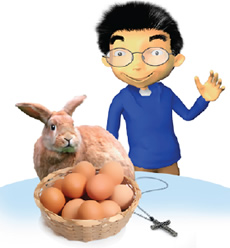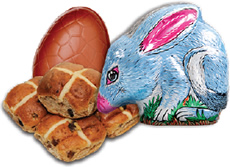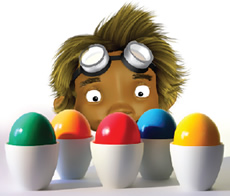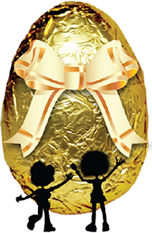Easter is a time for celebrating new life and is based around the Christian story of Jesus.
The Christian Easter
For Christians, Easter is about the crucifixion and resurrection (coming back to life) of Jesus Christ. After his death, Jesus’ body was put in a tomb (a type of grave). Three days later, the tomb was found to be empty, and people discovered that Jesus had risen.
Easter traditions

Easter is a Christian spring holiday which celebrates new life and rebirth. Many of its symbols, such as rabbits and eggs, come from ancient (really old) traditions.
Not everyone celebrates Easter at the same time. For example, the Greek Orthodox Church celebrates at a different time to the Catholic Church. Easter is not on the same date each year. It is usually celebrated somewhere between late March and late April.
Symbolism
Here are a few examples of common Easter symbols:
Crosses – Jesus was crucified on a wooden cross. These symbolise his death and resurrection.
Eggs – symbolise new life and rebirth.
Rabbits – symbolise new life.
Lambs – represent spring and new life.
Palm fronds – symbolise peace and have links to the bible which tells of Jesus being greeted with palm fronds when he arrived in Jerusalem a few days before he was arrested.
Purple – the colour of royalty and a sign of mourning.
Religious observances

Many Christians participate in a time called Lent (the forty days before Easter). During Lent some people give up simple items such as chocolate while others do not eat meat, fish, eggs or dairy.
The last week of Lent is called Holy Week. Palm Sunday (the first day of Holy Week) is the day that Jesus arrived in Jerusalem. Maundy Thursday is the day of the Last Supper and Good Friday is the day of Jesus’ crucifixion and death. Easter Sunday comes as a huge celebration at the end of Lent with feasting and treats, commemorating Jesus’ resurrection.
Easter in Australia

In Australia we celebrate Easter over a four day long weekend. It starts on Good Friday and ends on Easter Monday. Over the weekend you might attend a church service, have an Easter egg hunt or receive a chocolate egg or bilby.
Bilbies are like rabbits. They have long pointy ears and fine fur. People prefer bilbies in Australia as rabbits can be pests who steal native animals’ homes.
Another treat which Australians enjoy eating over Easter is the hot cross bun. These delicious treats are usually made with spices and dried fruit and decorated with a white cross, but you can also buy chocolate or fruitless hot cross buns.
Easter in other countries
Greece
Easter in Greece is a very religious time. Eggs are painted red to represent the blood of Christ. Traditionally, when people meet they knock their eggs together and say ‘Christos anesti!’ meaning ‘Christ is risen!’
Germany
Germany has many Easter traditions. Easter Sunday is known as ‘Family Day’. Lots of sweet treats are eaten, including a cake shaped like a lamb, and eggs and cookies are hidden in the garden.
Many Germans also have an ‘Easter Fire’ where they burn their Christmas tree to show that winter is over and spring is coming. It is also popular in Germany to have an egg tree. Real eggs are painted and then hung from branches in a vase inside the house.
Hungary

In Hungary, Easter is celebrated with the baking of delicious pastries and the painting of hardboiled eggs.
People in northeast Hungary celebrate with girls and boys wearing traditional dress. The girls run down the street while the boys throw buckets of water on them! Afterwards, the girls reward the boys with coins or Easter eggs painted with flowers.
Russia
As in many countries, eggs are decorated at Easter. During the nineteenth century, Russia took this to a whole new level of extravagance.
The Tsar Alexander III asked a jeweller named Peter Carl Fabergé to create an Imperial Easter Egg as a gift for the Empress each Easter. Each egg was made from precious stones and metals such as gold, silver, pearls, rubies and diamonds and took a whole year to make. When the egg was opened it held a surprise such as a beautiful pendant, a portrait or a golden hen.
Easter fast facts

- In Norway, it is popular to read a detective or crime novel over the Easter long-weekend.
- Eggs are often ‘blown’ to empty out the yolk and white before they are painted. Each end of the egg is pricked, and then air is blown into one end so that the yolk and white comes out of the other. The hollow eggshells can then be painted.
- It is believed that the word ‘Easter’ may come from ‘Eostre’ (sometimes called ‘Eostare’), the Anglo-Saxon goddess of sunrise and spring, who had festivals and feasts held in her honour during April.
- The cross on hot cross buns is there to remind us of Jesus, his crucifixion and resurrection.
- One of the world’s largest chocolate Easter eggs measured over 27 feet tall and weighed over 4000kgs.
- The day before Lent begins is called Shrove Tuesday or Pancake Day. Traditionally, a feast was held on this day to use up all of the food that people would not be able to eat during Lent. Pancakes were a popular recipe to get rid of eggs and milk.




